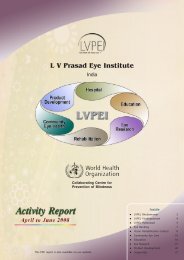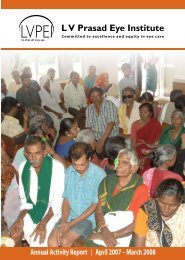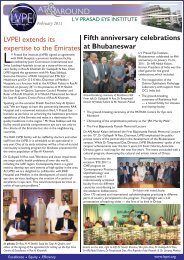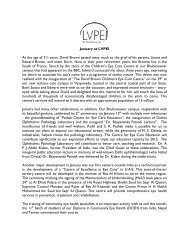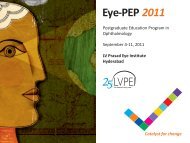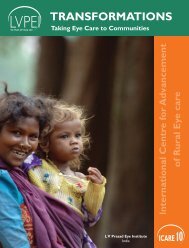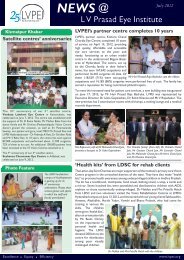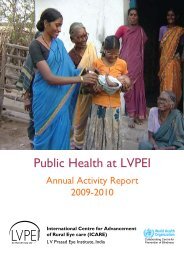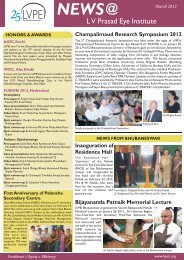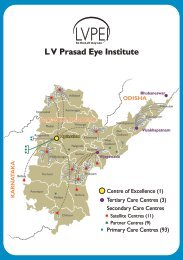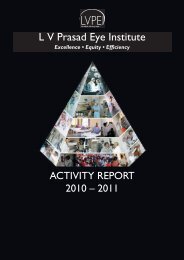Glimpses 2009-2010.pdf - LV Prasad Eye Institute
Glimpses 2009-2010.pdf - LV Prasad Eye Institute
Glimpses 2009-2010.pdf - LV Prasad Eye Institute
Create successful ePaper yourself
Turn your PDF publications into a flip-book with our unique Google optimized e-Paper software.
in the pathology laboratory, and statisticians—<br />
searched, Holmes-like, for clues that would lead<br />
them to understand the risk factors that led to<br />
tumor progression.<br />
“What followed was an intense period of dialogue—<br />
internally, mong clinicians and pathologists,<br />
externally, with specialist retinoblastoma groups—<br />
and we began to see that advanced retinoblastoma<br />
had to be treated differently, unlike the protocols<br />
commonly used in the west, where the cases<br />
presented much earlier.” The new protocols for<br />
advanced retinoblastoma now help salvage eyes and<br />
vision.<br />
“The question we are asking is, what makes it more<br />
likely for a cancer cell to spread from one part of<br />
the body (in this case, the eye) to another What<br />
Dr Santosh Honavar with a patient<br />
can we do to control that spread” Dr Honavar<br />
and his team then came up with a pre-emptive adjuvant therapy, where they instituted a treatment<br />
regimen based on an understanding of risk factors gained from the retrospective study. “As a direct<br />
consequence of this adjuvant therapy we have seen a substantial reduction in the number of children<br />
who die,” he says.<br />
“The climate at <strong>LV</strong>PEI is particularly conducive to this sort of innovation in patient care,” says<br />
Dr Honavar. The institute’s structure, combining basic and clinical research with an active public health<br />
and epidemiology program, facilitates a sharing of perspectives, he adds. “This has led to a higher level<br />
of internal referral, with more children being identified at a stage when they can be helped—to save<br />
their vision, and their life.”<br />
The work on retinoblastoma led to Dr Honavar’s being named as one of the winners of India’s most<br />
prestigious award for young scientists—the Shanti Swaroop Bhatnagar Award. But it has had other,<br />
more important consequences; it has led to the consolidation of a distinct subspecialty in eye care,<br />
ocular oncology, with students completing their training at the Jasti V Ramanamma Children’s <strong>Eye</strong> Care<br />
Centre, and moving on to take this approach to care to other centres in India and elsewhere. “I chose<br />
to come to <strong>LV</strong>PEI for my postgraduate training in oculoplasty because of what I had seen and heard of<br />
Dr Honavar’s work,” says Dr PM Fairooz, a resident. “He’s been an amazing mentor.”<br />
Ocular oncology as a specialization has<br />
gained tremendously from the work put<br />
in by Dr Honavar and his team, and the<br />
same culture permeates our centres in<br />
Bhubaneswar and Visakhapatnam. The<br />
Miriam Hyman Children’s <strong>Eye</strong> Care Centre<br />
in Bhubaneswar added a new pediatric<br />
cancer service this year, which will focus on<br />
early detection and care.<br />
Mr Prasanna Acharya, Minister for Health and Family<br />
Welfare, Govt. of Orissa (centre), Dr Taraprasad Das and<br />
Dr Sujata Das at the pediatric oncology unit<br />
Excellence Equity Efficiency Page<br />
12<br />
Inside_Pgs.indd 12<br />
8/30/2010 4:34:46 PM



